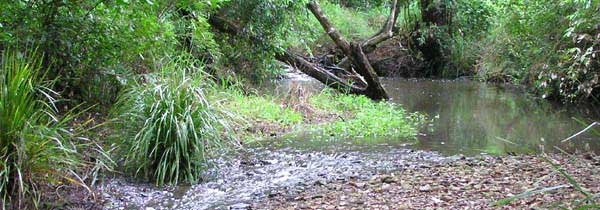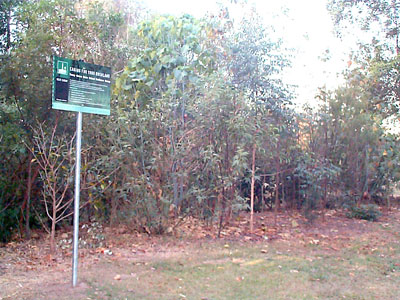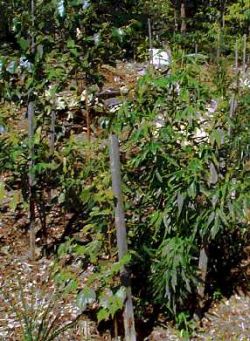 |
| Mid-morning sunshine brightens the Brook |
Bushcare activities
Contact us
On an upper stream in the North Brisbane catchment of Kedron Brook, a small mish-mash of revegetation occurs.
A number of projects occurring along Cedar Creek are aiming to achieve a greater integrity along the riparian (streamside) zone. A site that we at Cedar Creek Bushcare work on regularly is along this tributary of Kedron Brook. Cedar Creek drains parts of Brisbane Forest Park, Upper Kedron, northern slopes of Camp Mountain and Ferny Grove. It then joins with Kedron Brook before flowing through the northern suburbs of Brisbane before emptying into Moreton Bay.
Natural environment
The vegetation along the upper part of Kedron Brook has changed dramatically with urbanization and the introduction of weeds. The riparian zone of Cedar Creek is relatively healthy compared to other urban creeks, but is still degraded compared to its natural state.
Cedar Creek is still lucky to have natural creek lines with a good canopy overhead. (See photo right) However there are segments that have been cleared for a number reasons and are therefore prone to weed invasion.
The diversity of this catchment is substantial, with over 250 plant species recorded from the upper catchment of Kedron Brook. The drier hills contain Eucalypt forest, with gallery rainforests containing Waterhousia floribunda and Figs occurring along the creek line. An example of the health in the upper reaches of Kedron Brook in the 1930’s is well described by William J Lines (1998):
 Large eucalypts overhung the water. Their
roots penetrated deep into the banks and even under the creek. Stands
of blue gum and spotted gum, along with bloodwood and stringy bark,
grew adjacent to the creek. Casuarina trees and narrow leaf wattle,
which bloomed in August and loaded the air with a nutty gorse like
scent, studded the flood plain. The narrow leaf tea tree grew
among the wattle and flowered in early November. Its crushed leaves
smelled like thyme. Violet blossomed Sarsaparilla (Hardenbergia
violaceae) trailed across the ground in swathes seven metres long.
Purple flowered Hovea blossomed in late winter. Ground orchids grew
there as well. Butterflies – imperial blues and occasionally a Richmond
birdwing (one of Australia’s largest and most colourful butterflies) –
flitted between sun and shade.
Large eucalypts overhung the water. Their
roots penetrated deep into the banks and even under the creek. Stands
of blue gum and spotted gum, along with bloodwood and stringy bark,
grew adjacent to the creek. Casuarina trees and narrow leaf wattle,
which bloomed in August and loaded the air with a nutty gorse like
scent, studded the flood plain. The narrow leaf tea tree grew
among the wattle and flowered in early November. Its crushed leaves
smelled like thyme. Violet blossomed Sarsaparilla (Hardenbergia
violaceae) trailed across the ground in swathes seven metres long.
Purple flowered Hovea blossomed in late winter. Ground orchids grew
there as well. Butterflies – imperial blues and occasionally a Richmond
birdwing (one of Australia’s largest and most colourful butterflies) –
flitted between sun and shade.
Red crowned pigeons, golden bronzed cuckoos, kookaburras, a variety of waterbirds, including herons, egrets, spoonbills, water fowl and ducks, and between September and April, the migrating rainbow bee eaters, which nested in metre long tunnels dug into the bank or bare ground, and other birds of the Australian bush gathered by the stream. Black bitterns foraged along the creeks edges and perched on rocky outcrops. Colonies of flying foxes hung from the trees over the brook and fed on native blossoms.
Overhanging trees added leaf litter to the creek, which became food for yabbies, dragonfly larvae, mussels, and insects. Frogs croaked their mating calls after the first heavy rains. Tadpoles appeared. Turtles, bobbing in the water or sunning themselves on logs and sandbanks, were common. The web footed water rat and the platypus borrowed in the banks and fished the streambed for freshwater shrimp. The cool depths of the deep pools harboured native fish, freshwater cod, catfish and gudgeons. The most colourful form of the crimson spotted rainbow fish came only from the Kedron Brook. In season, mullet swarmed upriver. The mullet, large eels, freshwater prawns and lobbies (species of crustacean), as well as pigeon and duck, provided food for hungry out of work families and sport for boys and girls.

Bushcare activities
The visions seen in the 1930’s are one of our great aims for revegetation of Cedar Creek. We hope to increase the health of the creek through replanting of the creek banks and attempting to control and limit the effect of the exotic weeds. This will in turn help with providing a creek line that has a greater ecological integrity and thereby providing more habitat and natural values.
In the bigger picture, we hope to improve water quality by increasing the shade over the creek and reducing erosion. This will improve the water quality in Cedar Creek, Kedron Brook, and Moreton Bay.
We also feel revegetation is an important community activity. Relating to, and knowing, your local environment is an important aspect of sustainable communities. It is an opportunity to meet new people and learn from working on such a project.
Our present revegetation occurs in Council-owned bushland located behind the Ferny Grove Police Station. We have been working on the site for the last 2 years. This has mainly involved weed clearing and tree planting. The specific sites we have worked contain no overhead canopy and therefore have become completely weed infested.
We have had a good deal of help from a number of organisations. Brisbane City Council has provided plants, mulch, herbicide and advice to help us carry out the revegetation successfully.
Chris Milne, who has experience in an adjacent revegetation site, has provided guidance and plants for our site. Various friends and community groups such as Men of the Trees have helped to plant trees and do weeding.
Next working bee:
These are organised from time to time with details placed in advance on the local information boards
Contact us
If you are interested in participating in or finding out more about Cedar Creek Bushcare, you can email Bushcare Leader Tristan Peach at or by phone 3351 7143.
Contact details for Men of Trees from Fran Gilje by or phone 3851 0858
CI 14/10/2011

